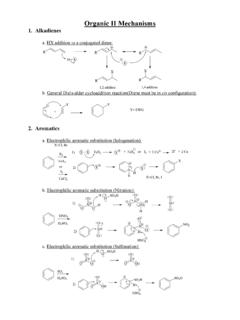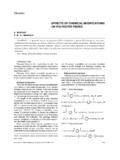Transcription of Esterification and Esters - VCSC Home
1 ESTERIFICATIONThis article describes methods for the production of carboxylic Esters :For the properties of these compounds, see Esters , ORGANIC. For Esters of inorganic acids, see the articles on nitric acid , phosphoricacids, sulfuric acid , are most commonly prepared by the reaction of a carboxylic acid and an alcohol with the elimination of water. Esters arealso formed by a number of other reactions utilizing acid anhydrides, acid chlorides, amides, nitriles, unsaturated hydrocarbons, ethers,aldehydes, ketones, alcohols, and Esters (via ester interchange). Detailed reviews of Esterification are given in References 1 the basis of bulk production (10), poly(ethylene terephthalate) manufacture is the most important ester producing polymer is produced by either the direct Esterification of terephthalic acid and ethylene glycol, or by the transesterification ofdimethyl terephthalate with ethylene glycol.
2 In 1990, poly(ethylene terephthalate) manufacture exceeded 3:47 106t=yr (seePOLYESTERS). Dimethyl terephthalate is produced by the direct Esterification of terephthalic acid and large-volume Esters are vinyl acetate [108-05-4] (VAM, 1:15 106t=yr), methyl methacrylate [80-62-6] (MMA,0:54 106t=yr), and dioctyl phthalate [117-81-7] (DOP, 0:14 106t=yr). VAM (see VINYL POLYMERS) is produced for the most partby the vapor-phase oxidative acetoxylation of ethylene. MMA (see METHACRYLIC POLYMERS) and DOP (see PHTHALIC ACIDS) areproduced by direct Esterification techniques involving methacrylic acid and phthalic anhydride, acetates of most alcohols are also commercially available and have diverse uses. Because of their high solvent power, ethyl,isopropyl, butyl, isobutyl, amyl, and isoamyl acetates are used in cellulose nitrate and other lacquer-type coatings (see CELLULOSE, Esters ).
3 Butyl and hexyl acetates are excellent solvents for polyurethane coating systems (see COATINGS; URETHANE POLYMERS). Ethyl,isobutyl, amyl, and isoamyl acetates are frequently used as components in flavoring (see FLAVORS AND SPICES), and isopropyl, benzyl,octyl, geranyl, linalyl, and methyl acetates are important additives in perfumes (qv).Reactions Between Organic Acids and AlcoholsIn the Esterification of organic acids with alcohols, it has been shown that in most cases under acid catalysis, the union is between acyland alkoxy groups. acid hydrolysis of acetoxysuccinic acid gives malic acid with retention of configuration at the asymmetric carbonatom (11):n-Amyl alcohol produced by basic hydrolysis of n-amyl acetate with 18O-enriched water does not contain 18O (12).
4 Effect of Structure. The rate at which different alcohols and acids are esterified as well as the extent of the equilibriumreaction are dependent on the structure of the molecule and types of functional substituents of the alcohols and acids. Specific data onrates of reaction, mechanisms, and extent of reaction are discussed in the following. More details concerning structural effects aregiven in References 6, 13 making acetate Esters , the primary alcohols are esterified most rapidly and completely, ie, methanol gives the highest yield andthe most rapid reaction. Ethyl, n-propyl, and n-butyl alcohols react with about equal velocities and conversions. Under the sameconditions, the secondary alcohols react much more slowly and afford lower conversions to ester products; however, wide variationsare observed among the different members of this series.
5 The tertiary alcohols react slowly, and the conversions are generally low(1 10% conversion at equilibrium). With isobutyl alcohol at 155 C, acids containing a straight-chain (acetic, propionic, and butyric)and phenylacetic and -phenylpropionic acids are esterified readily. Formic acid has the highest initial rate of reaction. Theintroduction of a branched chain in the acid decreases the rate of Esterification , and two branches cause a still greater retarding , the conversions to ester products from these substituted acids is higher than for the normal straight-chain acids. Similarly,aromatic acids, benzoic and p-toluic, react slowly but have high equilibrium introduction of a nitrile group on an aliphatic acid has a pronounced inhibiting effect on the rate of Esterification .
6 With thechloroacetic acids, the velocity decreases with increased chlorination. Double bonds also have a retarding influence on the rate ofesterification. Tests on substituted acrylic acids have shown that , -unsaturated acids are esterified much less easily than thesaturated analogues. A triple bond in the , position has about the same effect as a double bond. A , -double bond has less of a Esterification Vol 9 Kirk-Othmer Encyclopedia of Chemical Technology (4th Edition) 1 retarding action. If the double bond is sufficiently removed, as in erucic and brassidic acids (see CARBOXYLIC ACIDS), no effect is double bonds, when one is in the , -position, afford a great retarding effect. Cis-substituted unsaturated acids esterifymore slowly than the trans the preparation of ethyl Esters using anhydrous ethyl alcohol and hydrogen chloride catalyst, the rate of Esterification ofstraight-chain fatty acids from propionic through stearic is substantially constant: branching of the fatty acid chain causes the saturated dibasic acids, the rate of Esterification is a maximum at glutaric acid .
7 The ease of Esterification of the cycloparaffinmonocarboxylic acids increases in the order C3, C7, C6, C5, and C4 rings; with the exception of cyclopropanecarboxylic acid , theseare esterified more rapidly than the corresponding open-chain that displace electrons toward the carboxyl group of aromatic acids diminish the rate of the reaction (16). Thesubstitution of fluoromethoxy or ethoxy groups in the ortho position has an accelerating action, whereas iodo, bromo, nitro, ormethyl groups produce retardation. The influence of groups in the meta and para positions is not nearly so marked (17).Kinetic Considerations. Extensive kinetic and mechanistic studies have been made on the Esterification of carboxylicacids since Berthelot and Saint-Gilles first studied the Esterification of acetic acid (18).
8 Although ester hydrolysis is catalyzed by bothhydrogen and hydroxide ions (19,20), a base-catalyzed Esterification is not known. A number of mechanisms for acid - andbase-catalyzed Esterification have been proposed (4). One possible mechanism for the bimolecular acid -catalyzed ester hydrolysis andesterification is shown in equation 2 (6).This mechanism leads to the rate equation (eq. 3) for hydrolysis and to an analogous expression for the Esterification (13): d[E]dt=k1K1[E][H2O][H+]1+ k2K2[A][R0OH][H+]1+1= (3)In this expression, depends on those rate coefficients in the above mechanism whose values are assumed to be high. Othermechanisms for the acid hydrolysis and Esterification differ mainly with respect to the number of participating water molecules andpossible intermediates (21 23).
9 Applications of kinetic principles to industrial reactions are often useful. Initial kinetic studies of the Esterification reaction areusually conducted on a small scale in a well stirred batch reactor (24). In many cases, results from batch studies can be used in theevaluation of the Esterification reaction in a continuous operating configuration. Generally, the rate of Esterification with acid catalystis proportional to the acid or hydrogen ion concentration as well as the concentration of the alcohols and organic acid . The effect oftemperature on the reaction rate is given by the well known Arrhenius equation. These factors are interrelated, and may be used topredict optimum operational conditions for the production of a given ester if the necessary data are available, ie, the order of thereaction under the conditions to be used, a mathematical relation describing the yield with time, and an empirical equation relating thereaction rate constant with temperature, catalyst concentration, and proportions of these kinetic data and a knowledge of the reactor configuration, the development of a computer simulation model of theesterification reaction is invaluable for optimizing Esterification reaction operation (25 28).
10 However, all Esterification reactions donot necessarily permit straightforward mathematical treatment. In a study of the Esterification of 2,3-butanediol and acetic acid usingsulfuric acid catalyst, it was found that the reaction occurs through two pairs of consecutive reversible reactions of approximatelyequal speeds. These reactions do not conform to any simple first-, second-, or third-order equation, even in the early stages (29).In a study of the kinetics of the reaction of 1-butanol with acetic acid at 0 120 C, an empirical equation was developed thatpermits estimation of the value of the rate constant with a deviation of from the molar ratio of reactants, catalyst concentration,and temperature (30). This study was conducted using sulfuric acid as catalyst with a mole ratio of 1-butanol to acetic acid of 3 ,and a catalyst concentration of 0 wt %.


